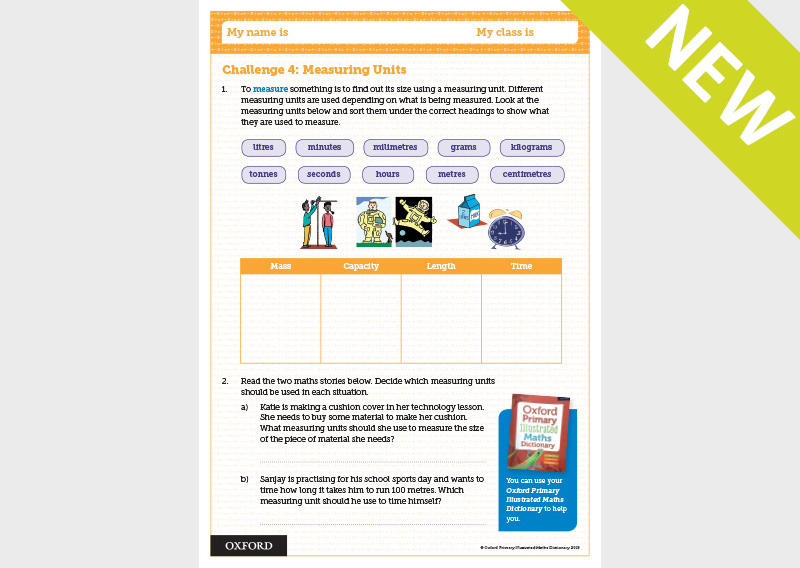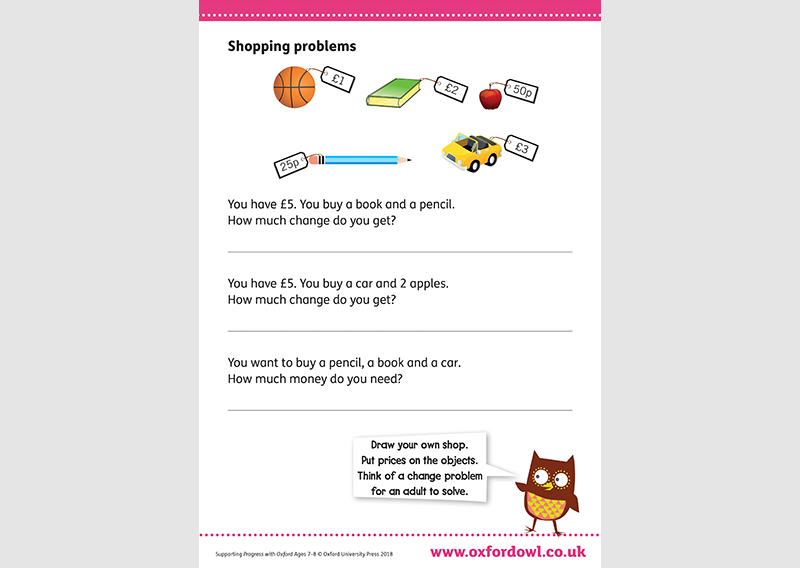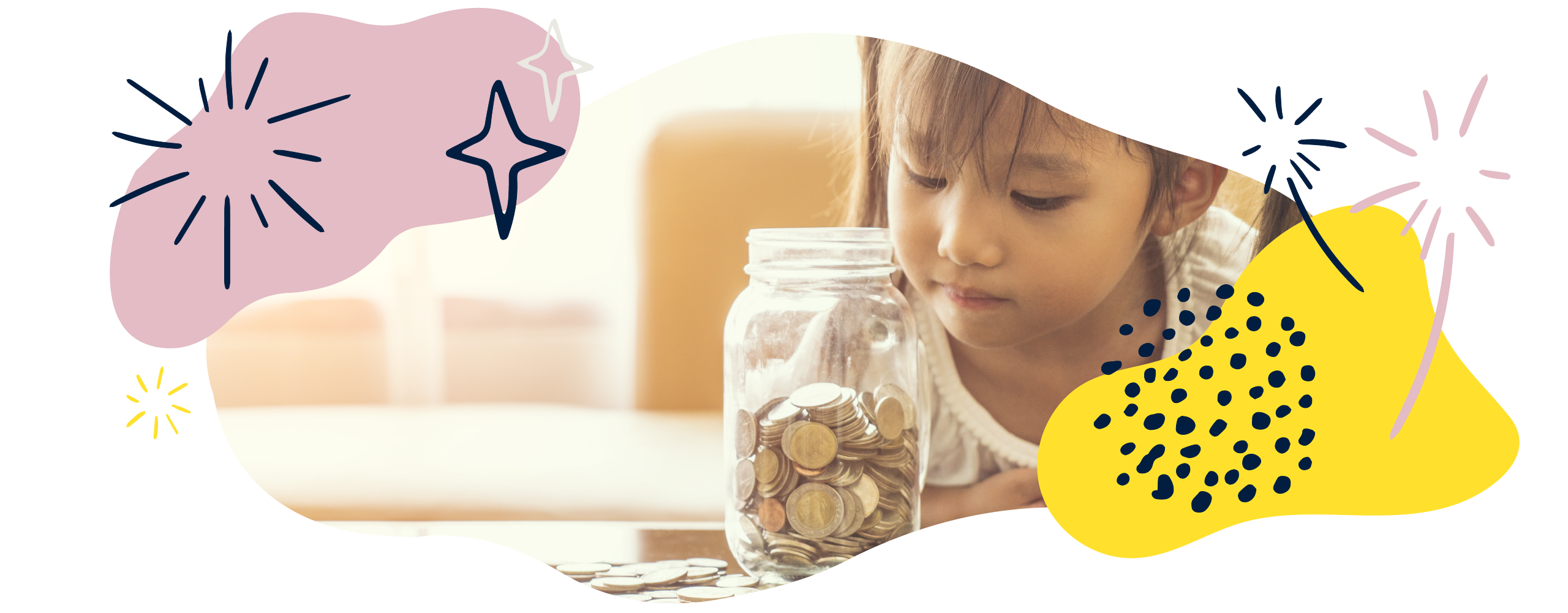Measurement in Year 3 (age 7–8)
In Year 3, your child will add and subtract measurements, will calculate with money, and will be able to talk about and tell the time very accurately. They will also start using Roman numerals.
The key words for this section are 2D, capacity, mass, and volume.
What your child will learn
Take a look at the National Curriculum expectations for measurement in Year 3 (age 7–8):
Measure, compare, and calculate with lengths, mass, and volume
Your child will compare measures. For example, they could say that a given quantity is twice as heavy or a length is five times as high as another. They will see how this connects to multiplication. They will also add and subtract measures, and will record their calculations using the appropriate units.
Measure the perimeter of simple 2D shapes
Your child will find the perimeter of simple 2D shapes by measuring the length of each side with a ruler and then adding the lengths together. They will record their calculations using centimetres.
Add and subtract amounts of money, using both £ and p
They will record money using the £ and p symbols separately (for example, ‘£2 and 35p’). It is important to note that the decimal recording of money (for example, £2.35) is introduced formally in Year 4.
Tell the time from analogue and digital clocks and use Roman numerals from I to XII
Estimate time to the nearest minute, record time, and use vocabulary of time
They will use vocabulary such as o’clock, am/pm, morning, afternoon, noon, and midnight.
Know how different units of time relate to one another
Your child will know that there are 60 seconds in a minute, and they will know the number of days in each month. They will also know the number of days in a year (including leap years).
Compare durations of events
Your child will learn to compare durations of time. For example, they should know that there are 60 seconds in a minute, so a minute is a longer duration of time than a second.
Your child will be able to calculate the time that an event or task takes. For example, if school starts at nine o’clock and playtime is at half past ten, they should be able to work out that there is an hour and a half between starting school and playtime.
How to help at home
There are lots of everyday ways you can help your child to understand measurement. Here are just a few ideas.
1. Measure in the real world
Planting sunflowers in the summer and measuring to see which one is the tallest can be a fun way to explore height in real life. Why not get together with family or friends to plant a group of flowers and then record and compare your findings every week? Who has the tallest sunflower? What is the height difference between the tallest and shortest sunflowers?
You could also try to point out measurement around the home. For example, your child could help you measure the wood needed for a building project or the ribbon needed for a craft activity. Ask them which unit they should use. For example, would you use kilometres, metres, centimetres, or millimetres to measure ribbon? Why?
2. Explore capacity using empty bottles
In the supermarket or at home, you could ask your child to read the capacity of milk cartons or bottles of squash. Discuss whether items are measured in litres or millilitres and why this might be.
To practise thinking about capacity at home, take a selection of empty containers and ask your child to estimate which container holds the most. Then, they can test out their estimates using a measuring jug. Be sure to show your child that they need to keep their eye level at the level of the water to measure accurately.
Remind your child what units they are using (for example, millilitres or litres) and help them to record and discuss their findings. Can they work out the difference between the capacity of the containers?
Activity: Measuring units

Sort the units and identify which units should be used in context.
Note: volume refers to how much space an object takes up, and capacity refers to how much you can fit inside an object. These are often similar but they are nonetheless different measures.
3. Round shopping
When you are out shopping for a few items, why not ask your child to estimate the total cost of the items in your basket? They will need to use their rounding skills to do this. When the items have gone through the till, compare the actual cost to your child’s estimate.
If you are paying with a note, you could ask your child to work out how much change you will receive. This will give them experience using money and will also practise their subtraction skills.
4. Play ‘what do I have in my purse?’
This game can help your child practise adding up different amounts of money. Take a purse and put five different coins in it. Ask your child to find the total, and then swap in some different coins and try again. For example:
You have a 1p coin, two 5p coins, a 50p coin, and a £2 coin. What does it make added together? (£2.61)
What if the 5p coins were replaced with 20p coins? (£2.91)
Activity: Shopping problems

Practise money skills and calculations.
5. Make a timetable
Make a timetable with your child including the time they get up, the time school begins, and the time they go to bed. They could record these times in four different ways:
- in analogue clock form
- in digital clock form using the 12-hour clock (remember to use am or pm)
- in digital clock form using the 24-hour clock
- in words.
Help your child understand how different units of time (seconds, minutes, hours, and so on) relate to each other. For example, they should know that there are 60 seconds in a minute, 24 hours in a day, and 12 months in a year.
You could test your child’s understanding by asking them questions about time durations. For example, if the party starts at 3pm and it takes an hour and a half to get to there, what time will we have to leave?
